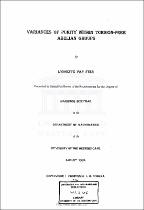Variances of purity within torsion-free Abelian groups
Abstract
In 1921, Prufer introduced the concept of a pure subgroup of an abelian group. This concept, which is applicable only to abelian groups, proved to be a very useful one. Subsequently, this concept has sparked off numerous definitions of subgroups of abelian groups which are either generalizations or refinements of the pure subgroup. We look firstly, at how these ideas have developed since Prufer's time. This picture has been gleaned by the perusal of the Mathematical Reviews to see which papers have been published regarding this topic and then, where available, by studying these papers to try to understand the rationale of the author.
Secondly, we group certain concepts which are comparable and then study the interrelation between these concepts.
In chapter 3.1, it is shown that, for a torsion-free abelian groupG, the following
conditions are equivalent:
(i) G is a finite rank completely decomposable group,
(ii) all pure subgroups of G are summands,
(iii) all pure subgroups of G are balanced in G.
One of the interesting results of section 3.2 is the theorem that states that a subgroup of a finite rank completely decomposable group is *-purely generated if and only if it is strongly regular pure and that of 3.3 is that any finite rank *-pure subgroup of a separable group is a completely decomposable summand.
Section 3.4 uses for a basis, the theorem proved by P. Hill and C. Megibben which states that a l-pure subgroup of a k-group is itself a k-group. What is so interesting about this theorem is that one of its corollaries states that a -pure subgroup of a separable group is also strongly pure.
The last section of the dissertation discusses the relationship between knice subgroups and balanced subgroups. A pure subgroup is knice if and only if it is balanced and its quotient group is a k-group. This result looks as though it could be helpful when trying to look at alternative definitions of balancedness.

